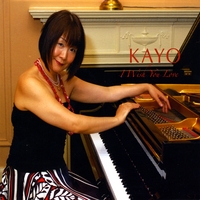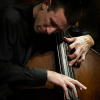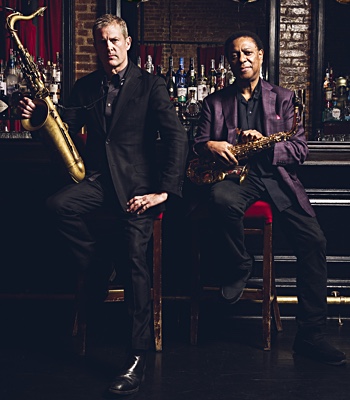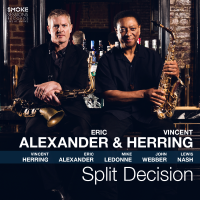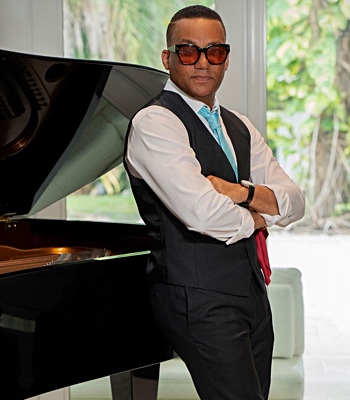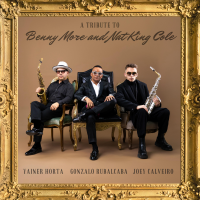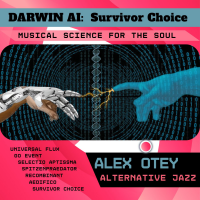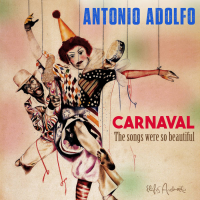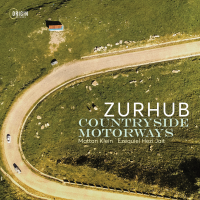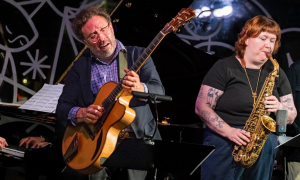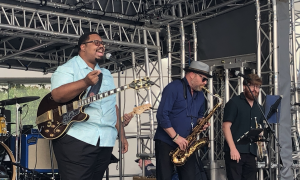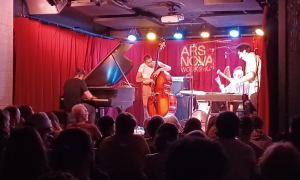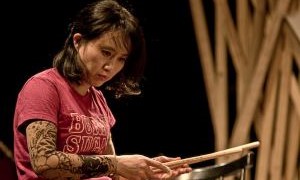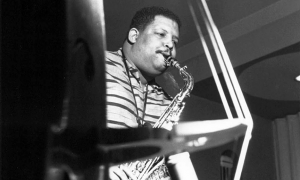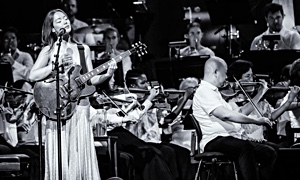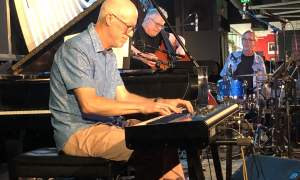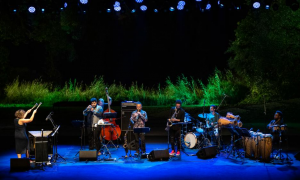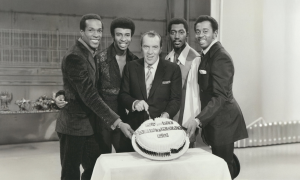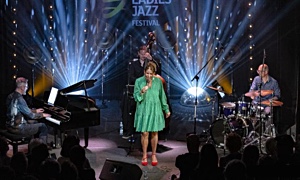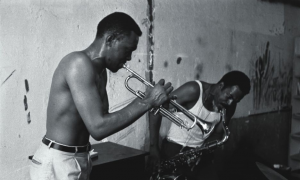Home » Jazz Articles » Live Review » DC Jazz Festival: June 1-13, 2011
DC Jazz Festival: June 1-13, 2011
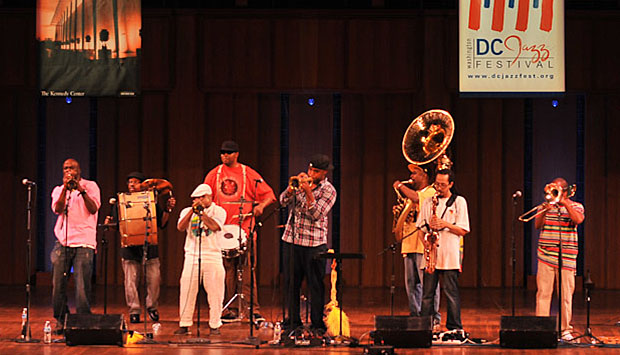
Washington, DC
June 1-13, 2011
The DC Jazz Festival's seventh year was defined in equal measure by the event's now distinct combination of local acts and headline guests, spread throughout the city's stages, museums, and local clubs. Unlike many festivals, the DC Jazz Festival has maintained an exclusive focus on jazz music and continues to place a spotlight on the local musicians that now more than ever are converting DC back into a vibrant jazz city. The DC Jazz Festival recipe has come to rely on some stock ingredients—Roy Hargrove and Eddie Palmieri were back for another round of Jazz on the Mall this year—but the 2011 lineup was leavened by several new additions that helped transform the two-week event into a life-affirming celebration of community and culture.
The two major new themes of the festival reflected the underlying inspirations of the festival organizers. First, the Capitol Bop-sponsored Loft Series brought together native bands with some of New York's most cutting edge artists to perform in impromptu spaces throughout the city. The inspiration of Giovanni Russonello, this homegrown endeavor gifted the festival with a roster of experimental jazz and a scene particularly appealing to younger audiences, fulfilling the festival's overall mission to entertain, educate, and expose. The second infusion was the bookending of the festival by two events focused on the music of New Orleans, a welcome addition that highlighted Washington, DC's cross-roads nature, its blend of Southern and East Coast sounds, tempos, and culture.
Opening Gala: Brass-A-Holics
The festival's cross-pollination was on full display during the gala opening on June 3rd, held at the French Embassy. Performing to a private audience of festival supporters, musicians, and city luminaries amidst a delectable spread served up by a host of DC's better eating establishments, the young New Orleans band Brass-A-Holics couldn't have opened the festival with a bigger bang. Fun, lively, and raw, the eight-person band got down to business right away, mixing traditional swing with hip-hop vocals, Go-Go rhythms and funk beats in an adrenaline surge of big, brassy energy.
Asked about his band's diverse style, bandleader and trombonist Winston Turner articulated his excitement at being in Washington and the connection he sees between the city's musical traditions, including of course both jazz and go-go:
"When you dance to New Orleans music it's a lot of foot work, it's a really groovin' rhythm, and when you hear [go-go] the movement and the sound is pretty much the same rhythm. Some of it is funky. It's got a street flavor. So when you hear both of them you have to dance. The dance steps that we actually do in New Orleans to traditional second line music you can do it over DC music—it's like you are already used to it and already appreciate it. We just try to use the same rhythm, the rhythm and playing horns over it is just so funky.... I am just so excited to be here, to be a part of what's going on, the music, the festival, everything."
That excitement, coupled with the infectious beats and interlocking horns of the band translated immediately to the crowd, transforming the night into one big party. By the end of the first song everyone was on their feet. By the second, the chairs had been abandoned, and as the band blasted away the crowd swirled, swayed, and mingled while sampling luxurious hand-made desserts from local bakery Cake Love, as well as potent cocktails, scrumptious crawfish étouffée from Acadiana, and a plethora of other treats.

Gala Second Line
The evening then culminated with Turner and company leading the crowd in a "second line" around the room. It didn't take long for the handkerchiefs to come out and the whole crowd to proceed marching throughout the space to the rhythm of the band—including, notably, jazz fan and festival supporter Congressman John Conyers.
An auspicious beginning, the Brass-A-Holics performance set at tone of casual ease, communal fun, and musicianship that would permeate the rest of the festival.
Basements and Lofts
Anchored by U-Street, the historic home-base of DC jazz, the DC Jazz Festival once again maximized the theaters, clubs, bars, and galleries of DC, infiltrating neighborhood nooks with everything from interactive children's shows, to swing brunches, to packed nights of intense music at the city's premier jazz clubs.
At the heart of the club scene, Bohemian Caverns presented the densest array of acts, including Carolyn Malachi, the Dizzy Gillespie All Stars Quartet, the Alex Brown Quintet, and two nights of the Heath Brothers. But while the Caverns put on one first-rate show after another, it did not monopolize the action. In fact, it was just down the street at Twins Jazz that one of the festival's absolute highlights took place, delivered by local vocalist Akua Allrich, whose breathtaking style has bewitched the District since she recently emerged on the scene.
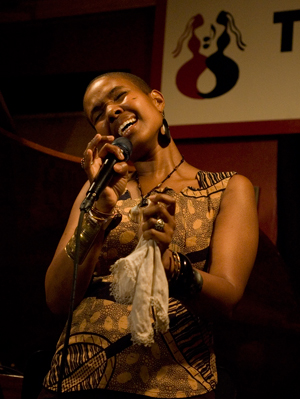 Allrich possess a stage presence and vocal range rivaling many of today's jazz divas, but it is her natural ease, contagious sense of joy, and blending of traditional jazz, modern influences, and African heritages that distinguishes her from even many of today's more established performers. Audiences lucky enough to have sampled Twins found Allrich catalyzed by a new band into delivering an unrestrained projection of her musical personality. Particularly startling was her rendition of "Afro-Blue," in which her personal connection to African culture and musical expression shone as she bent her voice in wordless atavistic calls, guttural cries, and thrashing moans over the undulant beats of the djembe. In the best tradition of jazz's female vocalists, Allrich combines the unabashedly sensual with a deeply powerful strength, clear artistic purpose, and organic individuality.
Allrich possess a stage presence and vocal range rivaling many of today's jazz divas, but it is her natural ease, contagious sense of joy, and blending of traditional jazz, modern influences, and African heritages that distinguishes her from even many of today's more established performers. Audiences lucky enough to have sampled Twins found Allrich catalyzed by a new band into delivering an unrestrained projection of her musical personality. Particularly startling was her rendition of "Afro-Blue," in which her personal connection to African culture and musical expression shone as she bent her voice in wordless atavistic calls, guttural cries, and thrashing moans over the undulant beats of the djembe. In the best tradition of jazz's female vocalists, Allrich combines the unabashedly sensual with a deeply powerful strength, clear artistic purpose, and organic individuality. At the same time that DC's established clubs and restaurants were attracting capacity crowds, the festival's newest addition, the DC Jazz Loft series, was busy opening the ears of a younger audience to jazz's vanguard musicians. The brainchild of Giovanni Russonello, the loft series launched earlier this year and was immediately integrated into the festival, providing yet another avenue for audiences to sample the breadth of today's jazz experience.
Inspired by the '70s loft movement which, birthed by necessity, found many of that generation's most innovative artists performing their free jazz and other musical experiments in improvised spaces throughout New York, Russonello's series takes a similar tack, appropriating everything from gallery spaces, to basement apartments, to empty warehouses in order to present modern jazz in a totally impromptu, casual atmosphere.
While it may be arguable whether the loft endeavor was a product of necessity or nostalgic indulgence, the results were compelling. Over the two week period, the loft series presented concerts by Thomas Fujiwara, Darius Jones, and the JD Allen Trio. As well, each night the series coupled these established New York innovators with a local act, providing fertile territory for the direct transfer of ideas so critical to jazz, while cultivating a growing sense of shared community. Most importantly, the music threatened to blow the roof off, capturing the imagination of audiences as they sat, stood, and lounged in unadorned, often sweltering rooms, passing six packs of bring-your-own beer as they absorbed the volatile outpouring of notes and blistering rhythms of the bands.
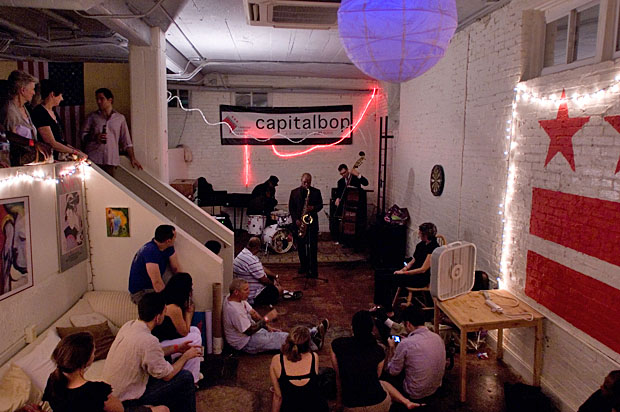
JD Allen Trio
During a pause in the final night of the series—headlined by the JD Allen Trio whose explosive integration of melodic, spiritual explorations and raw power provided another standout moment of the entire festival—one young audience member illustrated the impact of the DC Loft series.
"I've listened to a lot of blues before, older rock that is influenced by the blues, but this is a new world. It's a new experience that I'm glad to embrace. It's awesome."
Spiritual Visions
While the musical fare at the clubs and lofts provided the most experimental moments, the festival's larger acts also delivered memorable results. Two performances in particular—Bobby McFerrin's spiritually ennobling concert at the Warner Theater and the Kennedy Center-sponsored A Night in Treme—stood out as signature achievements not only of the year, but of the festival's history to date.
Uniting his unique vision and vocal prowess with Howard University's award-winning vocal jazz ensemble Afro Blue Reunion Choir, McFerrin went far beyond a mere translation of his recent ground-breaking album Vocabularies (EmArcy, 2010) to a stage performance. Grounded in the album's experimental integration of multiple vocal traditions, McFerrin converted DC's Warner Theater into a cathedral of sound, inviting the audience to participate in a revelatory exposition on the power of the human voice.
Performed entirely a capella and spanning African chants to European choral music, McFerrin's distinct vocal approach might seem like an ethnomusicological treatise if it weren't for his totally organic delivery that fuses humor, longing, religious depth, and simple humanism into a fully realized inspirational moment. Alternating between solo pieces and works performed with the Afro Blue, McFerrin first eased the audience into his auditory milieu with a chanting tune built on aboriginal rhythms before turning to "Baby," from his new album. Also performed solo, "Baby" expounded on a simple theme and lyric, transforming the repeated phrase "baby" into a challenge to envision the world we are creating for our children.
Next, McFerrin turned his attention to the American love affair with the car. Again using a capricious lyric as the foundation for a deeper meaning, McFerrin wove together multiple American rhythmic traditions to paint an insightful portrait of the American mythos of the cross-country getaway. McFerrin was then joined by Afro Blue for the first of the night's ensemble pieces, "Garden," also from the new album, which delved into overtly religious territory, encasing a meditation on Eden and the Tree of Life in a multi-voiced choir combining European choral traditions, African chants, and American pop soloing for a surprisingly heartfelt effect. Revealing McFerrin's ability to meld whimsy with wisdom, these tunes set the stage for the progression of the night, which, as it alternated between humor and profundity, drew the audience progressively further into McFerrin's syncretic musical universe and spiritual Weltanschauung—at the core of which lies an uplifting sense of joy.
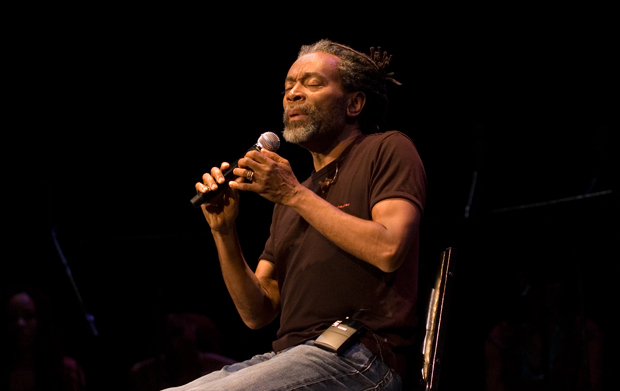 Bobby McFerrin
Bobby McFerrinOver the rest of the night, McFerrin brought forth an ever more complex vision, including duets exploring the scat tradition, a heart-rending solo spiritual calling on the redemptive power of Jesus, and a stand-out performance of "Messages," an extended work of sweeping beauty dedicated to the "messages we receive from those who went before us."
A resonant paean to the human experience, McFerrin's heterodox intermingling of the sacred and the secular stood out as a high point of the festival and emphasized this year's theme of musical diversity, also contributing further to the atmosphere of communal spirit and celebration.
Treme
Ending as it began, the final night of the 2011 DC Jazz Festival cast a spotlight on the music of New Orleans and in doing so hit a high water mark that etched in stark relief the lasting power of jazz and the gravitational pull of New Orleans culture.
Hosted by Wendell Pierce, who plays a key protagonist in the HBO series Treme (also of The Wire), and featuring music and musicians from the hit show, the closing concert was divided neatly in two halves, the first a scripted educational journey, the second a straightforward, roof-raising concert.
The first half of the concert mixed performance with education, providing a narrated history of New Orleans' musical culture with each element illustrated by a musical sample provided by the talented roster of musicians brought together for the event. Narrated by Pierce, this section provided audiences perhaps less familiar with the history and structures of New Orleans jazz a condensed lesson in the importance of Congo Square, the role of Indians and Big Chiefs, the origins of the second-line, and many other aspects important to appreciating the musical display about to come. Though heavily scripted, the musical interludes were fiery and freewheeling enough to get the capacity crowd to its feet, clapping to the rhythms and engaging in call-and-response exchanges with the band.
Pierce explained that the educational element was quite deliberate and one of the reasons he wanted to be part of the endeavor, as was striking a balance between providing information and providing an authentic musical experience,
"We went back and forth on the explanations for tonight. It may seem a little sing-song...It may sound a little pedantic and preaching to the choir, but there will be a lot of people who don't understand, for example, how social clubs [evolved]... , the social aid, the support people put together, that is culture in action."
Pierce went on to articulate the strength of culture and the powerful role the show Treme has had as a cultural transmitter in the rejuvenation of New Orleans and, as he sees it, a rejuvenation of the musical tradition both inside and outside of the city.
"There are people going around to restaurants in New Orleans because of the storyline in Treme. There are people who have never left St. Charles Ave. going, 'I knew about those Indians around the corner in the 'hood, but now I hate to say it, but I'm from New Orleans and I never really understood the Indian.' It's not just outside, it's people there too. It's a rejuvenation of the culture in a way that people understand its importance. That in turn becomes very important because we are fighting forces in New Orleans that are trying to get rid of that very community that created that culture.
"Most of the rejuvenation and revival of New Orleans is coming from the ground up. It is happening in spite of the incompetence and shortsightedness of government. And because it is coming from the ground up—from the people of New Orleans—because of that the culture is vital and has played a vital part in it. What we understand more than many other places is the importance of culture and what culture is. What thoughts are to the individual, culture is to society as a whole. It's where we get to reflect on who we are and who we hope to be. It's a vital part of life."
Opening the second half of the concert with a second-line march, the band whipped the capacity crowd into a furor as it blasted-out a rousing rendition of "Caravan." Led by Big Chief Donald Harrison on saxophone, the band wound its way through the aisles of the Kennedy Center's main concert hall, stopping at one point to respond with a private solo to one boisterous audience member's shouted "Go Big Chief, Go!"
By the time the band made it to the stage, not a single member of the 2,400 person crowd was left sitting, nor would they for the remainder of the concert. Taking control of the show, the Rebirth Brass Band proceeded to deliver one explosive tune after another, mixing classics like "Mardis Gras" with pop tunes, like "What Goes Around," and originals like "Feel like Funkin' it Up." Combining traditional swing with funk beats, hip-hop vocals, and a free-wheeling style, the band erupted with energy, quickly working the crowd into a frenzy that never seemed to plateau. Urged on by the band, the audience clapped, stomped, and shouted lyrics in time to the beats, everywhere you looked there was movement as kerchiefs waived from the packed balconies, couples danced first in the rows, then in the aisles.
Then, just when it seemed impossible for the energy level to rise any further, the band launched into the theme from Treme, igniting the crowd to further heights. Inspired, one couple literally ran down the center aisles, leapt onto the stage and began to swing-dance. In a flash, more followed, filling the stage and aisles with a dense pack of swinging, swaying bodies, as everyone laughed, clapped, and swung as the band closed out the show with the joyful sounds of Mardi Gras anthem, "Do Whatcha Wanna."
Leaving the show, one couldn't help but notice the grinning faces, the uplifted conversations, and the sense of togetherness birthed by the night's shared experience. The vitality of New Orleans' music and culture, displayed over the course of the night, proved not only a volatile intoxicant resulting in the most raucous, rambunctious, and communal experience to have occurred in the history of the Kennedy Center's many jazz performances, but also underscored the power of authentic culture to inspire and the hunger we all have for access to it.
Or, as Pierce summarized, "We've lost that sense of what culture is...It is entertaining, but it's not entertainment. Entertainment is a byproduct of culture. Culture is when you go and reflect on your existence... Anyone who came to this concert tonight will now not think of New Orleans without thinking about this night."
Conclusion
The 2011 DC Jazz Festival's series of events—from the small club dates, to the packed music halls—allowed audiences to sample the vast territory that is modern jazz, and to participate in a unique form of self-expression that is both an act of the individual artist and dependent on the collective experience. Though it happens only once a year, this shared experience has helped foster a renewed and ever-stronger jazz community in DC, as well as connect this community to musicians across the country. In an age of homogeneous, prepackaged, and thoroughly market-tested entertainment, the sprawling variety and communal spirit of the DC Jazz Festival stands as a reminder of the powerful role live, improvised music can play in defining a distinct culture and community.
Photo Credit
Top/Page 1: Greg "Fritz" Blakey
All Others: Franz Matzner
Tags
DC Jazz Festival
Live Reviews
Franz A. Matzner
Kim Smith Public Relations
United States
District Of Columbia
Washington
Roy Hargrove
Eddie Palmieri
Dizzy Gillespie
Heath Brothers
Akua Allrich
Darius Jones
JD Allen Trio
Bobby McFerrin
Rebirth Brass Band
Franz Matzner
Comments
PREVIOUS / NEXT
Support All About Jazz
 All About Jazz has been a pillar of jazz since 1995, championing it as an art form and, more importantly, supporting the musicians who make it. Our enduring commitment has made "AAJ" one of the most culturally important websites of its kind, read by hundreds of thousands of fans, musicians and industry figures every month.
All About Jazz has been a pillar of jazz since 1995, championing it as an art form and, more importantly, supporting the musicians who make it. Our enduring commitment has made "AAJ" one of the most culturally important websites of its kind, read by hundreds of thousands of fans, musicians and industry figures every month.
Go Ad Free!
To maintain our platform while developing new means to foster jazz discovery and connectivity, we need your help. You can become a sustaining member for as little as $20 and in return, we'll immediately hide those pesky ads plus provide access to future articles for a full year. This winning combination vastly improves your AAJ experience and allow us to vigorously build on the pioneering work we first started in 1995. So enjoy an ad-free AAJ experience and help us remain a positive beacon for jazz by making a donation today.Near
Washington Concerts
Sep
9
Tue
Sep
9
Tue
Sep
9
Tue


